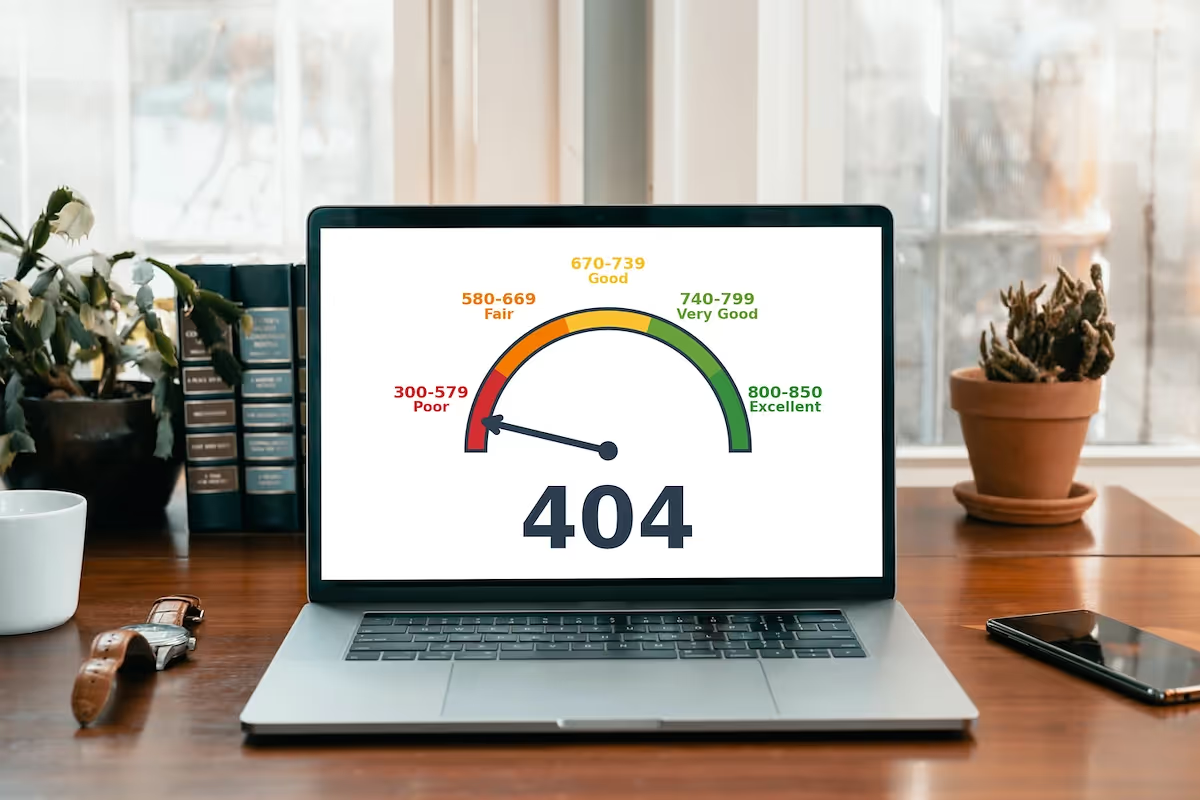
Kudos has partnered with CardRatings and Red Ventures for our coverage of credit card products. Kudos, CardRatings, and Red Ventures may receive a commission from card issuers. Kudos may receive commission from card issuers. Some of the card offers that appear on Kudos are from advertisers and may impact how and where card products appear on the site. Kudos tries to include as many card companies and offers as we are aware of, including offers from issuers that don't pay us, but we may not cover all card companies or all available card offers. You don't have to use our links, but we're grateful when you do!
404 Credit score: What You Need to Know in 2025
July 1, 2025


TL;DR
A 404 credit score presents a significant opportunity to build a stronger financial profile, serving as a clear baseline for improvement. This score falls squarely into the 'Poor' FICO credit score range, a foundation from which you can begin making impactful positive changes.
What Does a 404 Credit Score Mean?
A credit score of 404 places you squarely in the "poor" range of the FICO scoring model, which spans from 300 to 850. Lenders consider scores in this bracket to be high-risk, often signaling a history of payment issues or a very thin credit file. This number tells creditors that you may have significant difficulty managing and repaying debt.
Financially, this score can create substantial obstacles. Securing new credit cards, auto loans, or mortgages will be challenging, and any approvals will likely come with steep interest rates and unfavorable terms. While this presents immediate difficulties, it's crucial to know that credit scores are dynamic and can evolve with future financial habits.
Who Has a 404 Credit Score?
Credit scores generally improve with age, as people have more time to establish a positive payment history and build a longer credit file. According to 2023 Experian data, the average FICO score rises with each successive generation:
- Generation Z (ages 18-26): 680
- Millennials (ages 27-42): 690
- Generation X (ages 43-58): 709
- Baby Boomers (ages 59-77): 745
- Silent Generation (ages 78+): 760
Credit Cards With a 404 Credit Score
A credit score of 404 is considered very poor, which signals to lenders that you are a high-risk borrower. This makes it extremely difficult to get approved for most traditional credit cards, and you can expect to face rejections from major issuers. Your most viable options will likely be limited to secured credit cards, which require a security deposit, or specific subprime unsecured cards that come with high fees and interest rates.
Kudos uses its AI-powered tools to help you find the right credit card by asking about your specific needs and preferences through a personalization quiz. The platform then provides tailored recommendations from its database of nearly 3,000 cards, offering options suitable for various credit situations and helping you understand the potential impact on your credit score.
Auto Loans and a 404 Credit Score
A 404 credit score places you in the deep subprime category, which signals a high risk to lenders and results in steep interest rates. While you may still get approved for a loan, it will likely come with some of the least favorable terms and highest costs available.
According to 2025 auto loan data, average interest rates vary significantly across credit score tiers:
- Super-prime (781-850): 5.25% for new cars and 7.13% for used cars
- Prime (661-780): 6.87% for new cars and 9.36% for used cars
- Non-prime (601-660): 9.83% for new cars and 13.92% for used cars
- Subprime (501-600): 13.18% for new cars and 18.86% for used cars
- Deep subprime (300-500): 15.77% for new cars and 21.55% for used cars
Mortgages at a 404 Credit Score
With a 404 credit score, qualifying for a traditional mortgage is highly unlikely. Most lenders have minimum score requirements well above this, with conventional loans typically starting at 620. Even the most lenient government-backed option, an FHA loan, requires a score of at least 500. While some specialty non-prime lenders may consider scores this low, these opportunities are extremely rare and approval is never guaranteed.
If you manage to find a willing lender, a 404 score will severely impact your loan terms. You can expect significantly higher interest rates and be required to provide a large down payment. Your application will also face strict manual underwriting, where lenders scrutinize your income, debts, and the reasons behind your past credit issues before making a final decision.
What's in a Credit Score?
Figuring out what goes into your credit score can feel like trying to solve a complex puzzle, but it's primarily based on a handful of key financial habits. The most common factors include:
- Your payment history tracks whether you have paid past credit accounts on time.
- Credit utilization is the percentage of your available credit that you are currently using.
- The length of your credit history considers the age of your oldest account and the average age of all your accounts.
- Having a healthy mix of credit types, such as credit cards and installment loans, can positively impact your score.
- Recent credit inquiries and newly opened accounts can temporarily lower your score.
How to Improve Your 404 Credit Score
While a 404 credit score can feel discouraging, it's entirely possible to rebuild your financial standing with consistent, positive habits. With proven methods, meaningful changes can often be seen within three to six months of dedicated effort.
- Monitor your credit reports. Regularly check your reports for errors or fraudulent activity, as disputing and removing inaccuracies can provide a quick boost to your score. This is a critical first step to ensure your score isn't being unfairly held down by mistakes.
- Set up automatic payments. Payment history is the single most important factor in your credit score, so ensuring every bill is paid on time is essential. Automating payments prevents missed or late payments, which are a common cause of low scores and can further damage your credit.
- Apply for a secured credit card. For those with poor credit, a secured card requires a cash deposit but reports your payments to the credit bureaus just like a traditional card. This allows you to build a positive payment history and demonstrate responsible credit use when other options aren't available.
- Become an authorized user. If you have a trusted friend or family member with a good credit history, ask to be added as an authorized user on one of their accounts. This can add their positive payment history to your report and help improve your score without requiring a new credit application.
Using a financial companion like Kudos can help you manage your cards and monitor your score as you work to improve it.
Unlock your extra benefits when you become a Kudos member

Turn your online shopping into even more rewards

Join over 400,000 members simplifying their finances

Editorial Disclosure: Opinions expressed here are those of Kudos alone, not those of any bank, credit card issuer, hotel, airline, or other entity. This content has not been reviewed, approved or otherwise endorsed by any of the entities included within the post.



































.webp)



.webp)

.webp)


